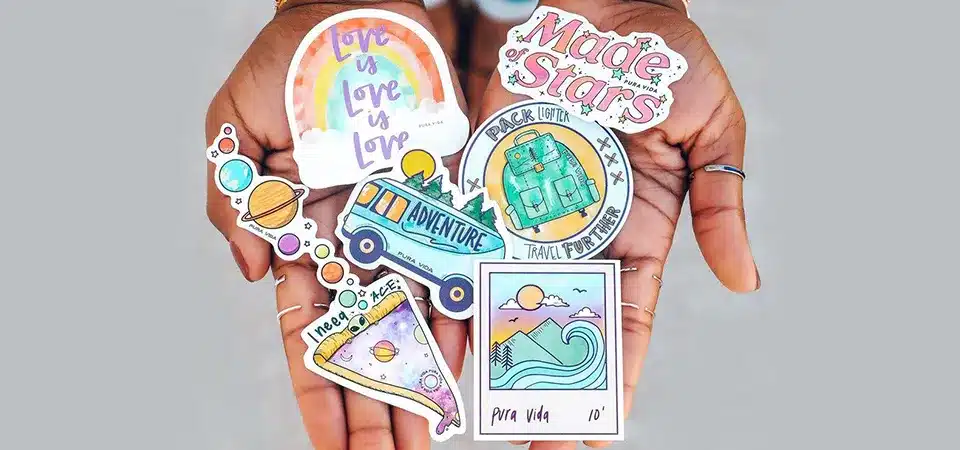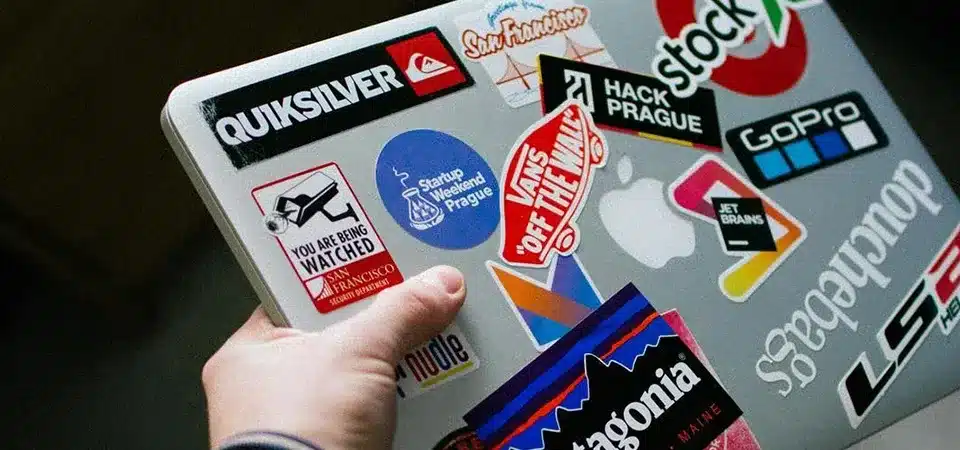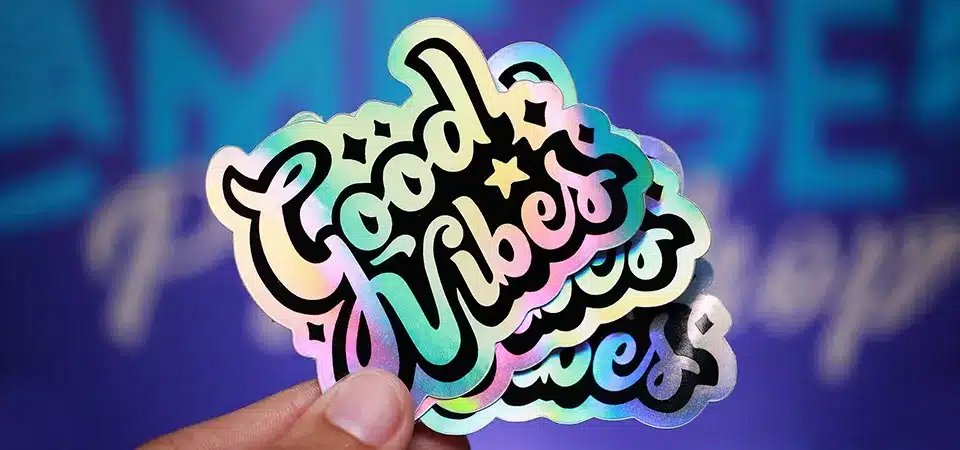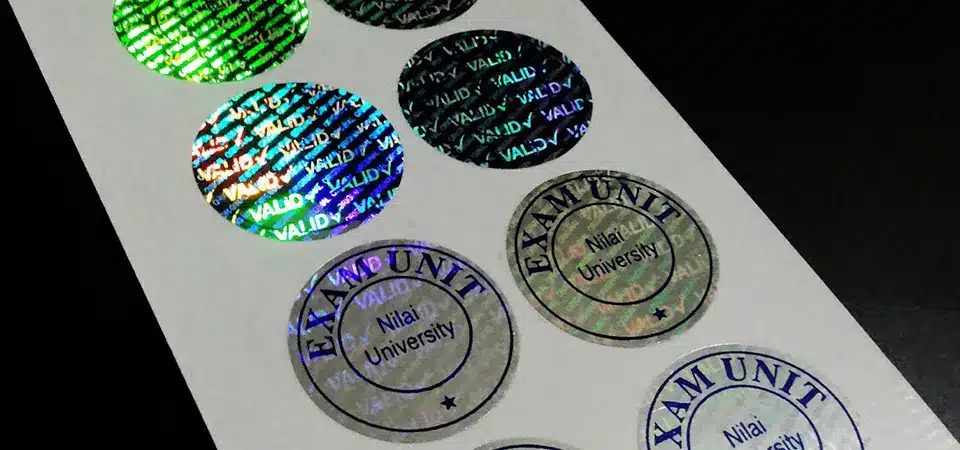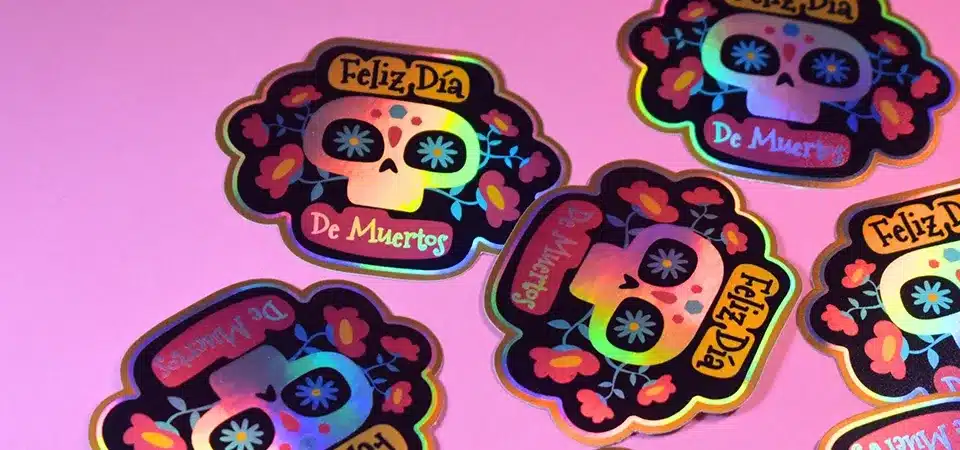Choosing between clear and white vinyl is tough. The wrong choice can make your design look unprofessional, clashing with your product and weakening your brand's impact.
White vinyl offers a solid, opaque background that makes colors pop. Clear vinyl is transparent for a minimalist "no-label" look, perfect for glass or smooth surfaces. The key difference is background opacity and how it impacts your design's visibility and style.
As a sticker printer, this is one of the most common questions I get from clients. Both materials are fantastic, but they serve very different purposes. To really pick the right one, we need to look closer at what makes each unique. Let's start with the classic: white vinyl.
What is a white vinyl sticker?
You need your sticker's colors to be bold and eye-catching. A transparent background could make your intricate design disappear on a dark or patterned surface.
A white vinyl sticker is printed on an opaque white material. This solid background acts like a canvas, ensuring your design's colors are true and vibrant, no matter what surface you apply it to. It offers maximum contrast and visibility.

Think of white vinyl as the foundation for your art. The material itself is a durable PVC, but its most important feature is that solid white base. This base guarantees that the colors you see in your digital proof are the colors you get on the final sticker. The CMYK inks we use for printing have a reliable, bright canvas to sit on, so nothing gets lost.
I had a client who sells coffee in beautiful, dark brown kraft paper bags. They had a colorful parrot logo that was full of bright reds, greens, and blues. If they had used a clear sticker, the dark bag would have absorbed all that color, and the logo would have looked dull and muddy. We printed their design on white vinyl, and the result was stunning. The parrot looked like it was ready to fly right off the bag. That's the power of a white background. It works on any surface—dark, light, patterned, or textured—making it the most versatile and reliable choice for complex or colorful designs.
What is a clear vinyl sticker?
You want a sleek, modern look for your product. A sticker with a solid white box around your logo can look clunky and cheap on a beautiful glass bottle.
A clear vinyl sticker is printed on a transparent material. It creates a seamless, "no-label" look that lets your product show through. It's perfect for minimalistic branding, especially on glass jars, bottles, or windows.
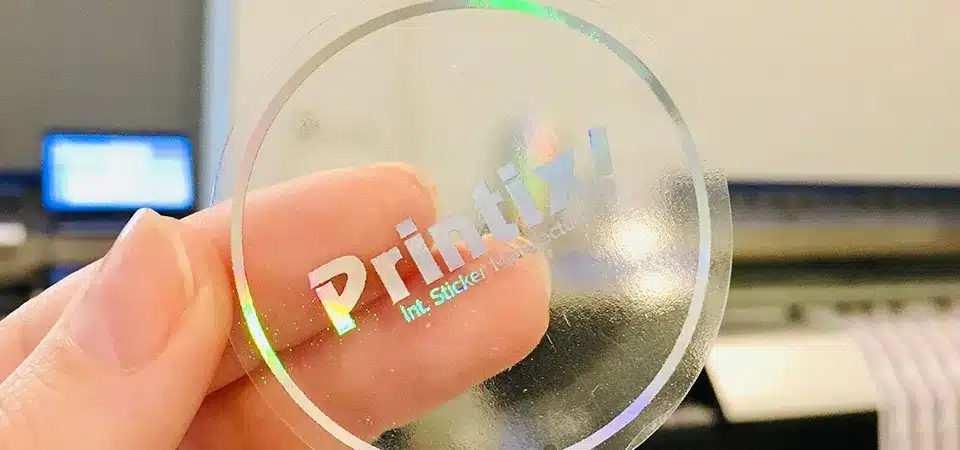
Clear vinyl is all about elegance and minimalism. It creates the illusion that your design was printed directly onto the surface. I love this effect for products where you want to show off what's inside, like a golden honey in a glass jar or a colorful juice in a bottle. It tells the customer, "we're proud of our product, and we have nothing to hide."
However, clear vinyl comes with a challenge: color visibility. Standard printing inks are translucent, which means they are slightly see-through. If you print a light color like yellow onto a clear sticker and then place it on a dark bottle, the yellow will almost disappear. This is where a special technique comes in: white ink underprinting. This is a service we offer where we print a precise layer of opaque white ink underneath the colored parts of your design. This white layer acts as a primer, making your colors bold and vibrant while the rest of the sticker remains perfectly clear. It gives you the best of both worlds: the vibrant colors of white vinyl with the sleek, "no-label" look of clear vinyl.
Clear vs white printable vinyl: what are the key differences?
You're still unsure which one fits your project. Making the wrong call wastes time and money on stickers that don't deliver the right visual impact for your brand.
The main difference is the background. White vinyl provides an opaque base for maximum color vibrancy on any surface. Clear vinyl is transparent, offering a sleek, "no-label" look but requires careful design consideration for color visibility.
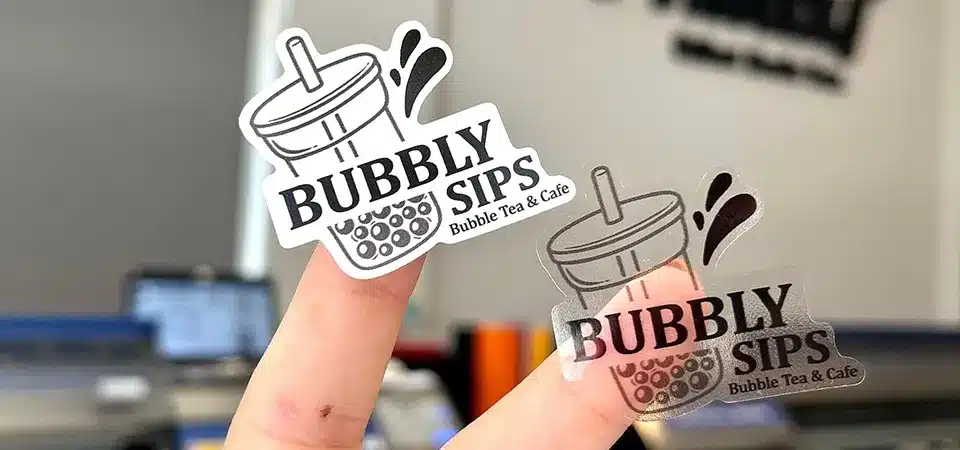
Choosing between the two really comes down to the job you need the sticker to do. One is about being bold and unmissable, while the other is about being subtle and integrated. I created this table to help my clients see the differences at a glance. It simplifies the decision by putting their core features side-by-side.
| Feature | White Vinyl | Clear Vinyl |
|---|---|---|
| Visual Effect | Bold, classic, solid background | Minimalist, "no-label" look |
| Best For | Detailed, colorful logos | Simple logos, window decals |
| Color Vibrancy | Excellent, true-to-proof colors | Depends on surface; may look faint |
| Surface Compatibility | Works on any color or pattern | Best on light or transparent surfaces |
| Design Needs | Straightforward, WYSIWYG | Requires planning for contrast; may need white ink |
Essentially, white vinyl is the safe bet for pure performance. Your colors will be perfect, and your sticker will be visible anywhere. Clear vinyl is the choice for a specific aesthetic. It requires a bit more thought about the surface color and design contrast, but the payoff is a sophisticated look that feels very premium.
How do I choose the right vinyl sticker for my project?
Theory is great, but now you have to make a real decision. Picking based on just looks can lead to a sticker that doesn't function as you need it to.
Choose white vinyl for vibrant, complex designs or application on dark/patterned surfaces. Choose clear vinyl for a minimalist look on glass or light-colored surfaces, or if you want to showcase the product itself.
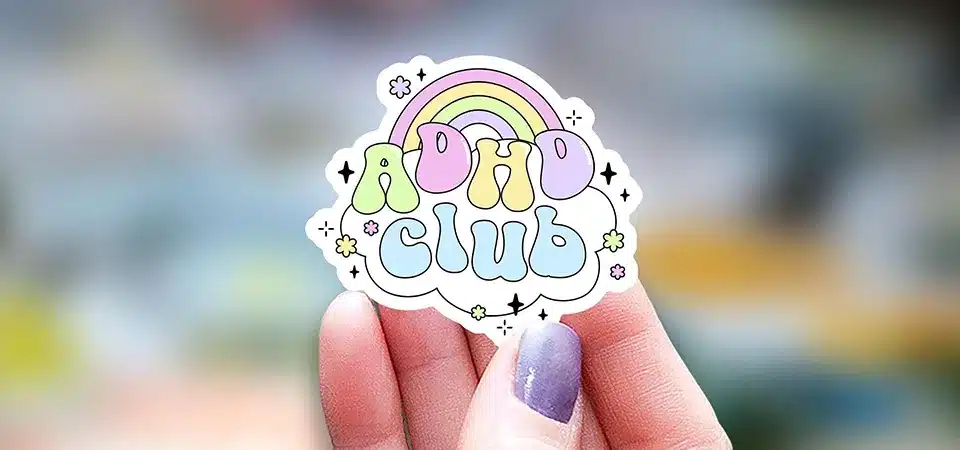
When a client is undecided, I walk them through a few simple questions. The answers almost always make the choice obvious. Ask yourself these three things, and you'll know exactly which material to choose for your project.
What surface will it go on?
This is the most important question. Take a look at your product's packaging or the surface where the sticker will live. Is it dark, colorful, or patterned? If so, white vinyl is your best choice. The opaque background will cut through the noise and make sure your design is seen clearly. Is the surface a clear glass bottle, a window, or a light-colored, plain box? If so, clear vinyl will look fantastic and create that professional, integrated feel.
What does my design look like?
Now, look at your logo or artwork. Is it filled with fine details, multiple colors, or subtle gradients? White vinyl will act as the perfect canvas to preserve every one of those details. Is your design simple, bold, and text-based? A minimalist logo in black or a dark color will look incredibly sharp and sophisticated on clear vinyl.
What story am I telling about my product?
Finally, think about your brand. Do you want to shout your message with fun, vibrant energy? White vinyl delivers that loud and proud look. Do you want to whisper elegance and quality, letting the product itself do most of the talking? Clear vinyl provides that subtle, high-end touch.
What are popular uses for clear and white vinyl stickers?
You need some inspiration to see how these stickers work in the real world. Without examples, it's hard to visualize which is right for your own brand.
White vinyl is popular for product labels, branding stickers, and laptop decals where color is key. Clear vinyl is a favorite for window clings, beverage bottles, and cosmetics to create a premium, "printed-on" look.

Seeing how other brands use these materials can spark some great ideas. Over the years, I've noticed clear trends in how my clients use each type of sticker. Each material has its own set of strengths that make it perfect for specific jobs.
Common uses for white vinyl stickers:
- Product Labels on Opaque Packaging: Perfect for coffee bags, cardboard boxes, and cosmetic tins where you need a clean slate for your branding.
- Promotional and Laptop Stickers: The opaque background ensures a logo is instantly recognizable and looks great on any color of laptop or water bottle.
- Bumper Stickers: They need to be bright, bold, and easy to read from a distance, which is exactly what white vinyl delivers.
- Safety and Information Labels: Legibility is critical, and the high contrast of white vinyl guarantees the text is clear.
Common uses for clear vinyl stickers:
- Food and Beverage Jars/Bottles: Ideal for honey, jam, kombucha, wine, and spirits. The "no-label" look feels organic and high-end.
- Window Decals: For storefronts or cars, clear stickers allow logos to float on the glass without obstructing the view.
- Cosmetic Product Labels: A clear label on a serum bottle or lotion tube looks sleek, modern, and clean.
- Subtle Branding: Placing a simple logo on electronics or gift boxes with a clear sticker is a touch of understated elegance.
How can I get the best results with my vinyl stickers?
You've chosen your material, but a poor design file can still lead to a disappointing result. Don't let a technical mistake ruin your perfect sticker.
For best results, use high-resolution vector files (like AI or EPS). For clear stickers, specify where you need a white ink underbase. Always clean the application surface before sticking to ensure a strong, bubble-free bond.
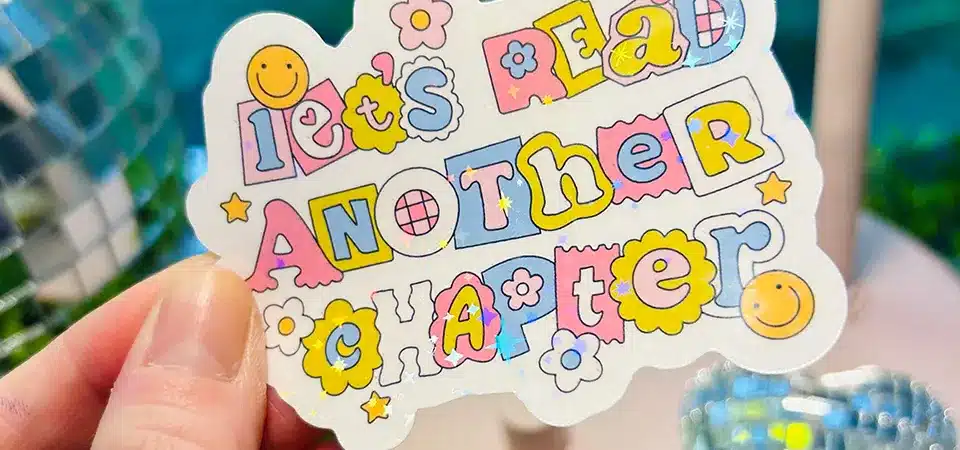
The final quality of your sticker depends on two things: a great design file and proper application. As a printer, I can only work with what I'm given, so preparing your file correctly is the most important step you can take.
File preparation is crucial
Your sticker will only be as sharp as your file. For logos and illustrations, you should always use a vector format (like an Adobe Illustrator AI file, EPS, or SVG). Vector graphics are made of lines and curves, not pixels, so they can be scaled to any size without losing quality. If you must use a pixel-based image like a JPG or PNG, make sure it has a resolution of at least 300 DPI (dots per inch) at the final print size. For clear stickers, if you need that white ink underbase, you have to tell us where to put it. The best way is to provide a separate layer in your vector file, often named "White_Ink," that shows us the exact shape to print in white behind your colors.
Application for a perfect finish
Even the best sticker will fail if it's applied to a dirty surface. Before you stick it, make sure the surface is clean, dry, and smooth. I recommend wiping it down with a little rubbing alcohol on a lint-free cloth to remove any oils or dust. For larger stickers, use the "hinge method" to prevent bubbles: tape the sticker in place along one edge, peel back the backing paper from the opposite side, and slowly smooth it down with a plastic card as you remove the rest of the backing.
Clear or white vinyl — which one is right for you?
You've learned a lot, but now it's time for the final decision. Let's simplify everything down to make the choice clear and confident for your brand.
Choose white vinyl for maximum impact, color vibrancy, and versatility on any surface. Choose clear vinyl for a subtle, premium, "no-label" look that highlights your product, especially on glass or light-colored packaging.
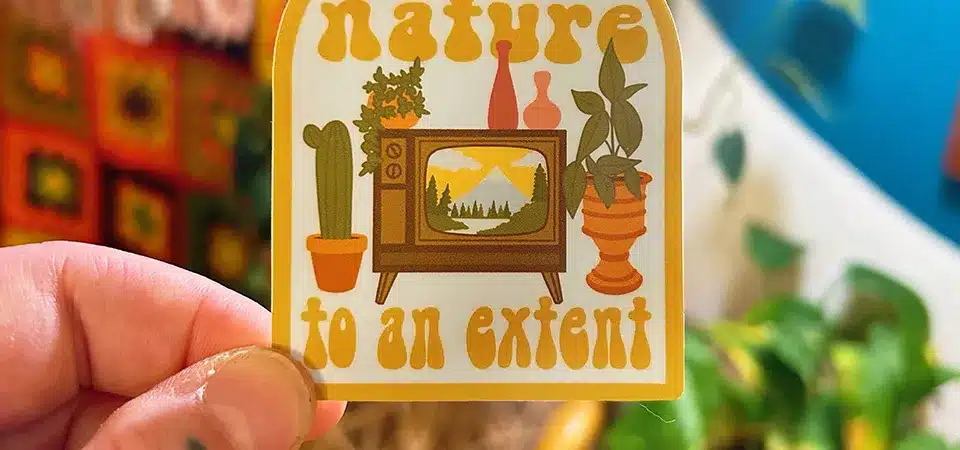
Ultimately, the choice isn't about which material is "better"—it's about which material tells the right story for your brand. Let's put it in simple terms.
If your brand is loud, colorful, and fun, and your stickers are meant to be seen on laptops, water bottles, and equipment, white vinyl is your best friend. It acts as a megaphone for your design, shouting your message with full-color confidence no matter where it's placed. It’s reliable, straightforward, and always makes a big impact.
If your brand is elegant, minimalist, and natural, and you're labeling beautiful glass jars or sleek cosmetic bottles, clear vinyl is your go-to. It provides that high-end, almost invisible touch that speaks of quality and sophistication. It doesn’t scream for attention; it enhances the product it's on, creating a seamless and professional finish. The right sticker is an extension of your brand identity, so pick the one that matches the personality you want to project.
Conclusion
Ultimately, white vinyl offers bold visibility, while clear vinyl provides a subtle, premium look. The right choice depends entirely on your design, product, and desired brand aesthetic.

